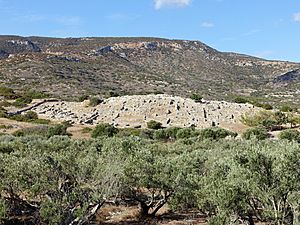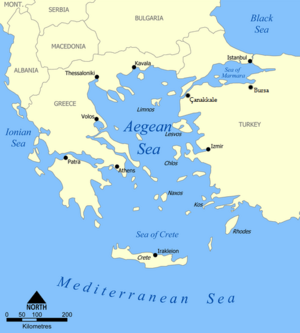Harriet Boyd Hawes facts for kids
Quick facts for kids
Harriet Boyd Hawes
|
|
|---|---|
 |
|
| Born |
Harriet Ann Boyd Hawes
October 11, 1871 |
| Died | March 31, 1945 (aged 73) |
| Nationality | American |
| Education | Smith College |
| Occupation | Archaeologist at Wellesley College |
Harriet Ann Boyd Hawes (October 11, 1871 – March 31, 1945) was an amazing American archaeologist, nurse, and professor. She is famous for discovering and leading the first digs at Gournia. This was one of the first times a Minoan town and palace were found on the island of Crete. She was also the first woman archaeologist to speak at the Archaeological Institute of America.
Contents
Growing Up and School
Harriet Ann Boyd was born in Boston, Massachusetts. Her mother passed away when Harriet was young. Her father raised her and her four older brothers. Her brother, Alex, first introduced her to studying Classics, which means learning about ancient Greek and Roman times. After attending the Prospect Hill School, she graduated from Smith College in 1892. She earned a degree in Classics, focusing on ancient Greek.
Starting Her Career
After teaching for four years, Harriet followed her dream of studying Greece and its ancient culture. She went to the American School of Classical Studies in Athens, Greece. She had planned to study in England, but decided on Greece instead. This was after hearing the archaeologist Amelia Edwards speak. While in Greece, she also volunteered as a nurse in Thessaly. This was during the Greco-Turkish War (1897). She wanted to join the school's archaeological digs. However, her professors told her to become a librarian instead.
In 1899, Hawes received the Agnes Hoppin Memorial Fellowship. She was frustrated because she wasn't allowed to be an active archaeologist. So, she used her fellowship money to go to Crete on her own. She wanted to find ancient ruins, especially around Gournia on the island's northeastern coast. She made this choice even though the area was still recovering from the Greco-Turkish War (1897) and wasn't very safe.
Harriet could speak Greek very well. Also, her work with the Red Cross during the war helped her. The local people trusted her, which was important for her work. In Crete, she visited the Knossos dig led by British archaeologist Arthur Evans. He suggested she explore the Kavousi region.
Hawes quickly became known for her archaeology skills. For four months in the spring of 1900, she led a dig at Kavousi. There, she found settlements and cemeteries from the Late Minoan IIIC, Early Iron Age, and Early Archaic periods (1200-600 BC). These were at sites called Vronda and Kastro. During the same trip, she dug a test trench at Azoria. This is an important ancient Greek site, which was an early city (around 700-500 BC). Azoria is still being excavated today.
Later Academic Work
Later in 1900, Hawes returned to the United States. She took a job at Smith College teaching Greek Archaeology. She also taught about ancient writings and modern Greek. She earned her master's degree from Smith in 1901. She taught at Smith until 1905, often traveling for archaeological trips.
Between 1901 and 1904, Harriet Boyd Hawes went back to Crete. She was on leave from Smith College. During this time, she discovered and excavated the ancient Minoan town at Gournia. This was on the northeastern coast of the island. Hawes was the first woman to lead a major archaeological project in Greece. Her team had over 100 workers! She was also the first archaeologist to find and fully dig up an Early Bronze Age Minoan town site.
The artifacts found at Gournia were shared. Some went to the Heraklion Archaeological Museum in Crete. Others went to the University of Pennsylvania Museum of Archaeology and Anthropology, which helped fund her digs. Her classmate from Smith College, Edith Hall Dohan, assisted her. In 1902, Harriet talked about her discovery during a lecture tour in the United States. She was the first woman to speak before the Archaeological Institute of America. Her report, called Gournia, Vasiliki and Other Prehistoric Sites on the Isthmus of Hierapetra, was published in 1908. She dug up many more Bronze and Iron Age settlements in the Aegean Sea area. She became a recognized expert on the region. In 1910, Smith College gave her an honorary doctorate degree. From 1920 until she retired in 1936, she taught about pre-Christian art at Wellesley College.
Nursing During Wars
Harriet Boyd Hawes also helped as a nurse during wars after she graduated from Smith College. She cared for injured soldiers in the Greco-Turkish War (1897), the Spanish–American War (1898), and World War I. During World War I, she brought supplies to Corfu for wounded soldiers in the Serbian Army (1915). She also helped the wounded in France (1916). In 1917, she started the Smith College Relief Unit in France. Boyd Hawes directed this unit for three years. She also worked as a nurse's aide at the YMCA. After returning home, she continued to support the war effort. She gave lectures to raise money for the Smith College Relief Unit.
Her Family Life
During one of her trips to Crete, she met Charles Henry Hawes. He was an English anthropologist and archaeologist. He later became a director at the Boston Museum of Fine Arts. They got married on March 3, 1906. Nine months later, their son, Alexander Boyd Hawes, was born. Their daughter, Mary Nesbit Hawes, was born in August 1910. At that time, Charles was teaching at Dartmouth College, and the family lived in Hanover. In 1920, the family moved to Cambridge, Massachusetts. Harriet then joined the faculty at Wellesley College. Hawes always stayed dedicated to her academic and archaeological work, as well as to her family.
Later Life and What She Left Behind
When Charles retired in 1936, the couple moved to Washington D.C. Harriet stayed there after her husband passed away. She died on March 31, 1945, at 73 years old. Even though she died in 1945, her work at the Gournia excavation site left a lasting mark on history. She started uncovering the ancient Minoan town on the northeastern coast of Crete. Her work in the early 1900s helped pave the way for the modern excavations at Gournia, which are still happening today.
Her childhood home in Chester Square is part of the Boston Women's Heritage Trail.
In 1992, her daughter, Mary Allsebrook, published a book about her called Born to Rebel: the Life of Harriet Boyd Hawes. The book was edited by Annie Allsebrook, Harriet Boyd Hawes' granddaughter.
Her Writings
- Gournia, Vasiliki and other prehistoric sites on the isthmus of Hierapetra, Crete; excavations of the Wells-Houston-Cramp expeditions, 1901, 1903, 1904. By Harriet Boyd Hawes, Blanche E. Williams, Richard B. Seager, Edith H. Hall. (Philadelphia, The American exploration society, Free museum of science and art 1908).
- Charles Henry Hawes and Harriet Boyd-Hawes, with a preface by Arthur J. Evans. Crete, the forerunner of Greece (London, 1909).
- Boyd, H.A. 1901. “Excavations at Kavousi, Crete, in 1900,” American Journal of Archaeology 5, 125–157.
- Boyd, H.A. 1904. “Gournia. Report of the American Exploration Society's Excavations at Gournia, Crete, 1902-1905,” in Transactions of the Department of Archaeology: Free Museum of Science and Art University of Pennsylvania I, Philadelphia, 7–44.
Books About Her
Adams, Amanda (2010), Ladies of the Field: Early Women Archaeologists and Their Search for Adventure, Douglas & McIntyre, ISBN: 978-1-55365-433-9
Allsebrook, Mary (2002), Born to Rebel. The Life of Harriet Boyd Hawes. Edited by Annie Allsebrook. First published in 1992, reprited with corrections and a postscript, Oxbow Books, ISBN: 1-84217-041-4
See also
 In Spanish: Harriet Boyd Hawes para niños
In Spanish: Harriet Boyd Hawes para niños




